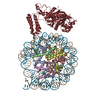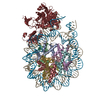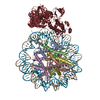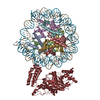[English] 日本語
 Yorodumi
Yorodumi- PDB-8hag: Cryo-EM structure of the p300 catalytic core bound to the H4K12ac... -
+ Open data
Open data
- Basic information
Basic information
| Entry | Database: PDB / ID: 8hag | ||||||
|---|---|---|---|---|---|---|---|
| Title | Cryo-EM structure of the p300 catalytic core bound to the H4K12acK16ac nucleosome, class 1 (3.2 angstrom resolution) | ||||||
 Components Components |
| ||||||
 Keywords Keywords | TRANSFERASE/DNA / Acetyl taransferase /  Complex / Complex /  Nucleosome / Nucleosome /  TRANSFERASE / TRANSFERASE-DNA complex TRANSFERASE / TRANSFERASE-DNA complex | ||||||
| Function / homology |  Function and homology information Function and homology informationbehavioral defense response / protein propionyltransferase activity / peptidyl-lysine propionylation / histone lactyltransferase activity / peptidyl-lysine crotonylation / peptidyl-lysine butyrylation / histone butyryltransferase activity / histone H3K122 acetyltransferase activity /  swimming / peptide butyryltransferase activity ...behavioral defense response / protein propionyltransferase activity / peptidyl-lysine propionylation / histone lactyltransferase activity / peptidyl-lysine crotonylation / peptidyl-lysine butyrylation / histone butyryltransferase activity / histone H3K122 acetyltransferase activity / swimming / peptide butyryltransferase activity ...behavioral defense response / protein propionyltransferase activity / peptidyl-lysine propionylation / histone lactyltransferase activity / peptidyl-lysine crotonylation / peptidyl-lysine butyrylation / histone butyryltransferase activity / histone H3K122 acetyltransferase activity /  swimming / peptide butyryltransferase activity / histone H2B acetyltransferase activity / swimming / peptide butyryltransferase activity / histone H2B acetyltransferase activity /  thigmotaxis / peptide 2-hydroxyisobutyryltransferase activity / histone crotonyltransferase activity / NOTCH2 intracellular domain regulates transcription / lysine N-acetyltransferase activity, acting on acetyl phosphate as donor / peptidyl-lysine acetylation / histone H4 acetyltransferase activity / histone H3 acetyltransferase activity / cellular response to L-leucine / internal peptidyl-lysine acetylation / NFE2L2 regulating ER-stress associated genes / peptide N-acetyltransferase activity / STAT3 nuclear events downstream of ALK signaling / acetylation-dependent protein binding / Activation of the TFAP2 (AP-2) family of transcription factors / NFE2L2 regulating inflammation associated genes / NGF-stimulated transcription / Polo-like kinase mediated events / histone H3K18 acetyltransferase activity / LRR FLII-interacting protein 1 (LRRFIP1) activates type I IFN production / N-terminal peptidyl-lysine acetylation / histone H3K27 acetyltransferase activity / NFE2L2 regulates pentose phosphate pathway genes / regulation of androgen receptor signaling pathway / NFE2L2 regulating MDR associated enzymes / positive regulation by host of viral transcription / regulation of mitochondrion organization / face morphogenesis / thigmotaxis / peptide 2-hydroxyisobutyryltransferase activity / histone crotonyltransferase activity / NOTCH2 intracellular domain regulates transcription / lysine N-acetyltransferase activity, acting on acetyl phosphate as donor / peptidyl-lysine acetylation / histone H4 acetyltransferase activity / histone H3 acetyltransferase activity / cellular response to L-leucine / internal peptidyl-lysine acetylation / NFE2L2 regulating ER-stress associated genes / peptide N-acetyltransferase activity / STAT3 nuclear events downstream of ALK signaling / acetylation-dependent protein binding / Activation of the TFAP2 (AP-2) family of transcription factors / NFE2L2 regulating inflammation associated genes / NGF-stimulated transcription / Polo-like kinase mediated events / histone H3K18 acetyltransferase activity / LRR FLII-interacting protein 1 (LRRFIP1) activates type I IFN production / N-terminal peptidyl-lysine acetylation / histone H3K27 acetyltransferase activity / NFE2L2 regulates pentose phosphate pathway genes / regulation of androgen receptor signaling pathway / NFE2L2 regulating MDR associated enzymes / positive regulation by host of viral transcription / regulation of mitochondrion organization / face morphogenesis /  Regulation of gene expression in late stage (branching morphogenesis) pancreatic bud precursor cells / RUNX3 regulates NOTCH signaling / NOTCH4 Intracellular Domain Regulates Transcription / Regulation of FOXO transcriptional activity by acetylation / Regulation of gene expression by Hypoxia-inducible Factor / Nuclear events mediated by NFE2L2 / Regulation of NFE2L2 gene expression / NOTCH3 Intracellular Domain Regulates Transcription / regulation of glycolytic process / platelet formation / NFE2L2 regulating anti-oxidant/detoxification enzymes / nuclear androgen receptor binding / megakaryocyte development / TRAF6 mediated IRF7 activation / regulation of tubulin deacetylation / macrophage derived foam cell differentiation / peptide-lysine-N-acetyltransferase activity / FOXO-mediated transcription of cell death genes / NFE2L2 regulating tumorigenic genes / internal protein amino acid acetylation / STAT family protein binding / Regulation of gene expression in late stage (branching morphogenesis) pancreatic bud precursor cells / RUNX3 regulates NOTCH signaling / NOTCH4 Intracellular Domain Regulates Transcription / Regulation of FOXO transcriptional activity by acetylation / Regulation of gene expression by Hypoxia-inducible Factor / Nuclear events mediated by NFE2L2 / Regulation of NFE2L2 gene expression / NOTCH3 Intracellular Domain Regulates Transcription / regulation of glycolytic process / platelet formation / NFE2L2 regulating anti-oxidant/detoxification enzymes / nuclear androgen receptor binding / megakaryocyte development / TRAF6 mediated IRF7 activation / regulation of tubulin deacetylation / macrophage derived foam cell differentiation / peptide-lysine-N-acetyltransferase activity / FOXO-mediated transcription of cell death genes / NFE2L2 regulating tumorigenic genes / internal protein amino acid acetylation / STAT family protein binding /  acyltransferase activity / fat cell differentiation / acyltransferase activity / fat cell differentiation /  protein acetylation / Formation of paraxial mesoderm / RUNX1 interacts with co-factors whose precise effect on RUNX1 targets is not known / positive regulation of transforming growth factor beta receptor signaling pathway / PI5P Regulates TP53 Acetylation / Zygotic genome activation (ZGA) / stimulatory C-type lectin receptor signaling pathway / protein acetylation / Formation of paraxial mesoderm / RUNX1 interacts with co-factors whose precise effect on RUNX1 targets is not known / positive regulation of transforming growth factor beta receptor signaling pathway / PI5P Regulates TP53 Acetylation / Zygotic genome activation (ZGA) / stimulatory C-type lectin receptor signaling pathway /  acetyltransferase activity / cellular response to nutrient levels / RUNX3 regulates p14-ARF / acetyltransferase activity / cellular response to nutrient levels / RUNX3 regulates p14-ARF /  NF-kappaB binding / NF-kappaB binding /  histone acetyltransferase complex / intrinsic apoptotic signaling pathway in response to DNA damage by p53 class mediator / negative regulation of tumor necrosis factor-mediated signaling pathway / canonical NF-kappaB signal transduction / Attenuation phase / negative regulation of protein-containing complex assembly / protein localization to CENP-A containing chromatin / negative regulation of gluconeogenesis / Chromatin modifying enzymes / Replacement of protamines by nucleosomes in the male pronucleus / histone acetyltransferase complex / intrinsic apoptotic signaling pathway in response to DNA damage by p53 class mediator / negative regulation of tumor necrosis factor-mediated signaling pathway / canonical NF-kappaB signal transduction / Attenuation phase / negative regulation of protein-containing complex assembly / protein localization to CENP-A containing chromatin / negative regulation of gluconeogenesis / Chromatin modifying enzymes / Replacement of protamines by nucleosomes in the male pronucleus /  somitogenesis / CENP-A containing nucleosome / pre-mRNA intronic binding / epigenetic regulation of gene expression / regulation of cellular response to heat / Packaging Of Telomere Ends / SARS-CoV-1 targets host intracellular signalling and regulatory pathways / skeletal muscle tissue development / somitogenesis / CENP-A containing nucleosome / pre-mRNA intronic binding / epigenetic regulation of gene expression / regulation of cellular response to heat / Packaging Of Telomere Ends / SARS-CoV-1 targets host intracellular signalling and regulatory pathways / skeletal muscle tissue development /  histone acetyltransferase activity / Recognition and association of DNA glycosylase with site containing an affected purine / Cleavage of the damaged purine / Deposition of new CENPA-containing nucleosomes at the centromere / histone acetyltransferase activity / Recognition and association of DNA glycosylase with site containing an affected purine / Cleavage of the damaged purine / Deposition of new CENPA-containing nucleosomes at the centromere /  Transferases; Acyltransferases; Transferring groups other than aminoacyl groups / Transferases; Acyltransferases; Transferring groups other than aminoacyl groups /  histone acetyltransferase / NR1H3 & NR1H2 regulate gene expression linked to cholesterol transport and efflux / transcription initiation-coupled chromatin remodeling / Regulation of TP53 Activity through Acetylation histone acetyltransferase / NR1H3 & NR1H2 regulate gene expression linked to cholesterol transport and efflux / transcription initiation-coupled chromatin remodeling / Regulation of TP53 Activity through AcetylationSimilarity search - Function | ||||||
| Biological species |   Homo sapiens (human) Homo sapiens (human) | ||||||
| Method |  ELECTRON MICROSCOPY / ELECTRON MICROSCOPY /  single particle reconstruction / single particle reconstruction /  cryo EM / Resolution: 3.2 Å cryo EM / Resolution: 3.2 Å | ||||||
 Authors Authors | Kikuchi, M. / Morita, S. / Wakamori, M. / Shin, S. / Uchikubo-Kamo, T. / Shirouzu, M. / Umehara, T. | ||||||
| Funding support |  Japan, 1items Japan, 1items
| ||||||
 Citation Citation |  Journal: Nat Commun / Year: 2023 Journal: Nat Commun / Year: 2023Title: Epigenetic mechanisms to propagate histone acetylation by p300/CBP. Authors: Masaki Kikuchi / Satoshi Morita / Masatoshi Wakamori / Shin Sato / Tomomi Uchikubo-Kamo / Takehiro Suzuki / Naoshi Dohmae / Mikako Shirouzu / Takashi Umehara /  Abstract: Histone acetylation is important for the activation of gene transcription but little is known about its direct read/write mechanisms. Here, we report cryogenic electron microscopy structures in which ...Histone acetylation is important for the activation of gene transcription but little is known about its direct read/write mechanisms. Here, we report cryogenic electron microscopy structures in which a p300/CREB-binding protein (CBP) multidomain monomer recognizes histone H4 N-terminal tail (NT) acetylation (ac) in a nucleosome and acetylates non-H4 histone NTs within the same nucleosome. p300/CBP not only recognized H4NTac via the bromodomain pocket responsible for reading, but also interacted with the DNA minor grooves via the outside of that pocket. This directed the catalytic center of p300/CBP to one of the non-H4 histone NTs. The primary target that p300 writes by reading H4NTac was H2BNT, and H2BNTac promoted H2A-H2B dissociation from the nucleosome. We propose a model in which p300/CBP replicates histone N-terminal tail acetylation within the H3-H4 tetramer to inherit epigenetic storage, and transcribes it from the H3-H4 tetramer to the H2B-H2A dimers to activate context-dependent gene transcription through local nucleosome destabilization. | ||||||
| History |
|
- Structure visualization
Structure visualization
| Structure viewer | Molecule:  Molmil Molmil Jmol/JSmol Jmol/JSmol |
|---|
- Downloads & links
Downloads & links
- Download
Download
| PDBx/mmCIF format |  8hag.cif.gz 8hag.cif.gz | 387.3 KB | Display |  PDBx/mmCIF format PDBx/mmCIF format |
|---|---|---|---|---|
| PDB format |  pdb8hag.ent.gz pdb8hag.ent.gz | 294.3 KB | Display |  PDB format PDB format |
| PDBx/mmJSON format |  8hag.json.gz 8hag.json.gz | Tree view |  PDBx/mmJSON format PDBx/mmJSON format | |
| Others |  Other downloads Other downloads |
-Validation report
| Arichive directory |  https://data.pdbj.org/pub/pdb/validation_reports/ha/8hag https://data.pdbj.org/pub/pdb/validation_reports/ha/8hag ftp://data.pdbj.org/pub/pdb/validation_reports/ha/8hag ftp://data.pdbj.org/pub/pdb/validation_reports/ha/8hag | HTTPS FTP |
|---|
-Related structure data
| Related structure data |  34588MC  8hahC  8haiC  8hajC  8hakC  8halC  8hamC  8hanC M: map data used to model this data C: citing same article ( |
|---|---|
| Similar structure data | Similarity search - Function & homology  F&H Search F&H Search |
- Links
Links
- Assembly
Assembly
| Deposited unit | 
|
|---|---|
| 1 |
|
- Components
Components
-Protein , 5 types, 9 molecules AEBFCGDHK
| #1: Protein |  Histone H3 / Histone H3/a / Histone H3/b / Histone H3/c / Histone H3/d / Histone H3/f / Histone H3/h / Histone ...Histone H3/a / Histone H3/b / Histone H3/c / Histone H3/d / Histone H3/f / Histone H3/h / Histone H3/i / Histone H3/j / Histone H3/k / Histone H3/l Histone H3 / Histone H3/a / Histone H3/b / Histone H3/c / Histone H3/d / Histone H3/f / Histone H3/h / Histone ...Histone H3/a / Histone H3/b / Histone H3/c / Histone H3/d / Histone H3/f / Histone H3/h / Histone H3/i / Histone H3/j / Histone H3/k / Histone H3/lMass: 15305.969 Da / Num. of mol.: 2 Source method: isolated from a genetically manipulated source Source: (gene. exp.)   Homo sapiens (human) Homo sapiens (human)Gene: H3C1, H3FA, HIST1H3A, H3C2, H3FL, HIST1H3B, H3C3, H3FC HIST1H3C, H3C4, H3FB, HIST1H3D, H3C6, H3FD, HIST1H3E, H3C7, H3FI, HIST1H3F, H3C8, H3FH, HIST1H3G, H3C10, H3FK, HIST1H3H, H3C11, H3FF, ...Gene: H3C1, H3FA, HIST1H3A, H3C2, H3FL, HIST1H3B, H3C3, H3FC HIST1H3C, H3C4, H3FB, HIST1H3D, H3C6, H3FD, HIST1H3E, H3C7, H3FI, HIST1H3F, H3C8, H3FH, HIST1H3G, H3C10, H3FK, HIST1H3H, H3C11, H3FF, HIST1H3I, H3C12, H3FJ, HIST1H3J Production host:   Escherichia coli (E. coli) / References: UniProt: P68431 Escherichia coli (E. coli) / References: UniProt: P68431#2: Protein |  Mass: 11345.289 Da / Num. of mol.: 2 Source method: isolated from a genetically manipulated source Source: (gene. exp.)   Homo sapiens (human) / Production host: Homo sapiens (human) / Production host:   Escherichia coli (E. coli) Escherichia coli (E. coli)#3: Protein | Mass: 14034.355 Da / Num. of mol.: 2 Source method: isolated from a genetically manipulated source Source: (gene. exp.)   Homo sapiens (human) / Gene: H2AC4, H2AFM, HIST1H2AB, H2AC8, H2AFA, HIST1H2AE / Production host: Homo sapiens (human) / Gene: H2AC4, H2AFM, HIST1H2AB, H2AC8, H2AFA, HIST1H2AE / Production host:   Escherichia coli (E. coli) / References: UniProt: P04908 Escherichia coli (E. coli) / References: UniProt: P04908#4: Protein | Mass: 13935.239 Da / Num. of mol.: 2 Source method: isolated from a genetically manipulated source Source: (gene. exp.)   Homo sapiens (human) / Gene: HIST1H2BJ, H2BFR / Production host: Homo sapiens (human) / Gene: HIST1H2BJ, H2BFR / Production host:   Escherichia coli (E. coli) / References: UniProt: P06899 Escherichia coli (E. coli) / References: UniProt: P06899#5: Protein | | Mass: 92314.391 Da / Num. of mol.: 1 Source method: isolated from a genetically manipulated source Source: (gene. exp.)   Homo sapiens (human) / Gene: EP300, P300 / Production host: Homo sapiens (human) / Gene: EP300, P300 / Production host:   Trichoplusia ni (cabbage looper) Trichoplusia ni (cabbage looper)References: UniProt: Q09472,  histone acetyltransferase, histone acetyltransferase,  Transferases; Acyltransferases; Transferring groups other than aminoacyl groups Transferases; Acyltransferases; Transferring groups other than aminoacyl groups |
|---|
-DNA chain , 1 types, 2 molecules JI
| #6: DNA chain | Mass: 55560.527 Da / Num. of mol.: 2 Source method: isolated from a genetically manipulated source Source: (gene. exp.)   Homo sapiens (human) / Production host: Homo sapiens (human) / Production host:   Escherichia coli (E. coli) Escherichia coli (E. coli) |
|---|
-Details
| Has ligand of interest | Y |
|---|
-Experimental details
-Experiment
| Experiment | Method:  ELECTRON MICROSCOPY ELECTRON MICROSCOPY |
|---|---|
| EM experiment | Aggregation state: PARTICLE / 3D reconstruction method:  single particle reconstruction single particle reconstruction |
- Sample preparation
Sample preparation
| Component | Name: the p300 catalytic core bound to the H4K12acK16ac nucleosome Type: COMPLEX / Details: p300 was expressed in insect cells. / Entity ID: all / Source: RECOMBINANT |
|---|---|
| Source (natural) | Organism:   Homo sapiens (human) Homo sapiens (human) |
| Source (recombinant) | Organism:   Escherichia coli (E. coli) Escherichia coli (E. coli) |
| Buffer solution | pH: 7.2 |
| Specimen | Embedding applied: NO / Shadowing applied: NO / Staining applied : NO / Vitrification applied : NO / Vitrification applied : YES : YES |
Vitrification | Cryogen name: ETHANE |
- Electron microscopy imaging
Electron microscopy imaging
| Experimental equipment |  Model: Titan Krios / Image courtesy: FEI Company |
|---|---|
| Microscopy | Model: TFS KRIOS |
| Electron gun | Electron source : :  FIELD EMISSION GUN / Accelerating voltage: 300 kV / Illumination mode: FLOOD BEAM FIELD EMISSION GUN / Accelerating voltage: 300 kV / Illumination mode: FLOOD BEAM |
| Electron lens | Mode: BRIGHT FIELD Bright-field microscopy / Nominal defocus max: 2000 nm / Nominal defocus min: 800 nm Bright-field microscopy / Nominal defocus max: 2000 nm / Nominal defocus min: 800 nm |
| Image recording | Electron dose: 50 e/Å2 / Film or detector model: GATAN K3 BIOQUANTUM (6k x 4k) |
- Processing
Processing
| Software |
| ||||||||||||||||||||||||
|---|---|---|---|---|---|---|---|---|---|---|---|---|---|---|---|---|---|---|---|---|---|---|---|---|---|
CTF correction | Type: PHASE FLIPPING AND AMPLITUDE CORRECTION | ||||||||||||||||||||||||
3D reconstruction | Resolution: 3.2 Å / Resolution method: FSC 0.143 CUT-OFF / Num. of particles: 113423 / Symmetry type: POINT | ||||||||||||||||||||||||
| Refinement | Cross valid method: NONE Stereochemistry target values: GeoStd + Monomer Library + CDL v1.2 | ||||||||||||||||||||||||
| Displacement parameters | Biso mean: 277.3 Å2 | ||||||||||||||||||||||||
| Refine LS restraints |
|
 Movie
Movie Controller
Controller











 PDBj
PDBj






















































